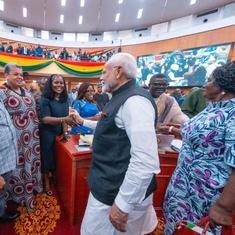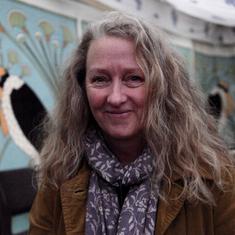Three images acted together as the guiding spirit which motivated me to start writing this book. One can refer to them as the markers of the journey I referred to earlier, which Pakistani women undertook after 1947. The first of these images that sets the theme for this project was taken by photographers associated with Life magazine’s special issue commemorating the celebrations for the brand new Pakistani state. It is of the members of the National Voluntary Guards, with the women guards themselves being a new concept for the fledgling state.
The women in the photograph are fluid in their motion, parrying out and lunging with sticks as they pose for the camera amidst drills – my problems with militaristic values in the public space notwithstanding, for some this image of women might depict the hopes and aspirations of the new nation. The Pakistani nation and Jinnah, the founder patron, were aware that they had embarked on a particular experiment of political Islam – not to forget how the women’s question would be articulated in the new state.
As they pose for the cameras, it is clear that the young women and their well-wishers are united in the firm belief that Pakistani women will play a significant role when it comes to shaping the destiny of their new state. There was, however, the sound of rumblings on the horizon; the mullahs (clergy) of Pakistan had expressed their displeasure at the institution of the women guards and their presence in the celebrations of the new state. Some of the clergy had issued religious edicts against women parading with their heads uncovered and bosoms exposed, fuming that these women would be staring into eyes of men, and be left with no shame and dignity. Perhaps their displeasure was an indication of the years ahead. Rather than writing their own destiny, the status of Pakistan’s women would be the words to how the state eventually turned out.
Sixty years after these youthful images, another generation of young Pakistani women also posed for the cameras carrying sticks. However, in these images it is difficult to gauge their exuberance from the all-enveloping black cloaks that cover their bodies and faces.
We know that they are equally determined as their sisters were six decades ago to play a role in Pakistan’s destiny from their headbands that read “Impose Shariah or Embrace Martyrdom”. As they posed for the foreboding images that graced Pakistan’s morning newspapers, the nation knew that it stood at the brink of a social revolution that would have far-reaching consequences in the days ahead.
The third is a mental image that I carry from interviews with young students at a seminary for women. In November 2006, a young Pakistani student had looked me straight in the eye and declared, “I have told my parents that we are a radical lot here and one day I am going to be part of Pakistan’s inqilab (social revolution).” Remarkable sentiments these, and what was more astonishing was that this solemn declaration was being made by an eight-year-old girl studying at a seminary in the Pakistan’s Khyber Pakhtunkhwa.
The words stayed with me till later in the month when young women studying at the Jamia Hafsa seminary (the women in black robes I refer to earlier on these pages) in Islamabad laid siege to a children’s library in the city. The Jamia Hafsa (a seminary for women) and Jamia Faridia (a seminary for male students) are affiliated with Islamabad’s infamous Red Mosque. The takeover of the children’s library and the subsequent “Impose Shariah or Embrace Martyrdom” conference organised by Jamia Hafsa were the first steps in their long stand-off with the Pakistan government.
The students also kidnapped women whom they accused of spreading immorality, and then held hostage the policemen who had come to free them. This was followed by raiding clinics run by Chinese doctors in Islamabad and kidnapping some of them. The state did move in to crush the movement, albeit too late, and the final encounter was tragic and bloody. The repercussions of the ill-thought Operation Silence, launched in July 2007 to take over the Red Mosque, Jamia Hafsa and Jamia Faridia, still haunt Pakistani policy makers today.

At the time and even now my question remains the same: when and how will the social aspirations of an adolescent woman translate into the coming of age of a social and political revolution in urban Pakistan?
Will this woman find a face, a resolution to her angst, or like Rosie the Riveter does she retreat to her cloister come daybreak? Like the Nameless Soldier, the Lal Majid student flits wraith-like through the pages of testimonies emerging after Operation Silence. She first emerges in the streets of Islamabad, an avenging force livid with the destruction of mosques in her city. With growing speed she sweeps through centres of commerce she accuses of spreading evil. However, later there are conflicting pieces of evidence: young students at the seminary claim that she is a celestial being, no mere mortal she but a tall angel who descended in the area to protect a faith in peril.
The proud figure who proudly strode the Lal Masjid compound during the Shahadat conference is later reduced to a shrouded figure in television interviews. Reciting ad nauseum the list of grievances, she gradually disappears from public space. She resurfaces only when there is talk of state torture, as one of many souls who irked a corrupt regime. I wanted her to be more than a passive, tortured woman – a stock image circulated and popularised by the reactionary press, and a mere statistic in the string of complaints against Musharraf’s regime.
It is ironic that for a gender pushed to the margins in Pakistan, it is a woman who becomes the narrator for the social and political climate of a particular decade. This could be the conflicted personality of Apa Nisar Fatima.
Fatima was a firebrand, a woman who had sided with General Zia as he curbed the mobility and life choices of Pakistan’s women. As part of General Zia’s infamous Majlis Shoora of the 1980s, Apa Nisar Fatima welcomed the spate of legislative reforms that played around with human rights and religious liberty. She would turn on women’s rights groups, and had once accused them of spreading blasphemy and passing sacrilegious statements against the personality of the Holy Prophet (a crime punishable by death).
It was an intriguing time in history where a Pakistani woman was asking of the state to curb her personal liberties and those of fellow Pakistani women as they were vulnerable to temptation and vice. How does one reconcile to this? The 1980s also had the fleeting scandal of Naseem Fatima, a young woman who convinced her community and family to walk across the Arabian Sea (and subsequently to their death) on a pilgrimage to Iraq.
According to the sociologist Akbar Ahmed,
“Naseem Fatima, ‘a shy, pleasant looking-girl with an innocent expression on her face, who had a history of fits’, after a series of miraculous religious experiences which were scorned by Sunni Muslims but were not inconsistent with Shia doctrine, led 38 people into the Arabian Sea at Karachi believing the waters would part and they would be transported miraculously to Shia holy sites in Karbala in Iraq. The women and children locked in five of the six trunks died. One of the trunks was shattered by the waves and its passengers survived. Those on foot also survived; they were thrown back onto the beach by the waves...The survivors were in high spirits – there was neither regret nor remorse among them, only a divine calm, a deep ecstasy. The Karachi police in a display of bureaucratic zeal arrested the survivors. They were charged with attempting to leave the country without visas...Rich Shias, impressed by the devotion of the survivors, paid for their journey by air for a week to and from Karbala. In Iraq, influential Shias, equally impressed, presented them with gifts, including rare copies of the Holy Quran.”
For a particular moment in time Fatima transcends the limits of gender, generation and class, courtesy religion and her faith. But both she and Apa Nisar have disappeared in the archives of press clippings from their decade.

Excerpted with permission from We Are All Revolutionaries Here: Militarism, Political Islam and Gender in Pakistan, Aneela Zeb Babar, Yoda Press and Sage.










